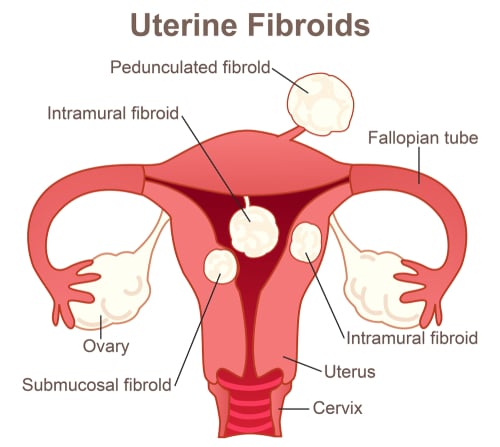Uterine fibroids affect around 70% of women. These growths are noncancerous and occur during childbearing years. They can range in size from nearly undetectable to a large mass that affects the nearby organs. For most women, they produce no symptoms and are undetectable. For others, fibroids can have a negative impact on their day-to-day life. Fibroids can come in three different types determined by where they grow in the uterus. These are:
- Intramural fibroids, which grow within the muscle wall
- Subserosal fibroids, which grow outward into the pelvic cavity
- Submucosal fibroids, which grow inward into the uterus
Some common symptoms of fibroids include heavy bleeding, irregular bleeding, pressure or pain, backache or leg-ache, and difficulty urinating. Submucosal fibroids are worth discussing with your gynecologist since they can often be the cause of some severe symptoms, even if they are small.
Why are submucosal fibroids important?
Submucosal fibroids, more so than the other kinds, can cause difficulties with reproductive health since they can affect the inside of the uterus. Although infertility and pregnancy problems can have many causes, submucosal uterine fibroids are a common culprit. Additionally, women with submucosal fibroids often experience heavy bleeding and longer periods than women without submucosal fibroids. This means it’s important to address submucosal fibroids that interfere with your quality of life.
How are submucosal fibroids diagnosed?
Your gynecologist can help diagnose fibroids during a routine pelvic exam. In many cases, your gynecologist will be able to feel any irregularities in your uterus as a base for further testing. Often, ultrasound imaging can be used to further locate the fibroids and generate an idea of how they may be affecting your uterus and reproductive health. Your gynecologist may also recommend a biopsy to determine whether any fibroids may develop into cancer.
How are submucosal fibroids treated?
There are some options for addressing submucosal fibroids depending on your diagnosis and test results. In some cases, your gynecologist may recommend waiting and simply monitoring any changes in your fibroids if they cause no symptoms. If they are not cancerous and don’t interfere with your daily and reproductive health, then there may be no need to treat them. However, if your gynecologist determines you may need to proceed to some treatment steps, then you have some options. Medications like certain types of birth control, Gonadotropin-releasing hormone (GnRH) agonists, and over-the-counter NSAIDs can often help manage heavy bleeding and discomfort. In some cases, non-invasive or minimally-invasive surgical procedures can be used to remove or reduce fibroids through different techniques. Your gynecologist can recommend your best options based on your health and symptoms.
Schedule an Appointment
Your first step in getting relief from fibroids is meeting with our expert gynecologists to discuss your symptoms, testing options, and treatments. To get started, contact our New York City office by calling or filling out our online form.

